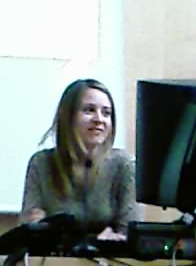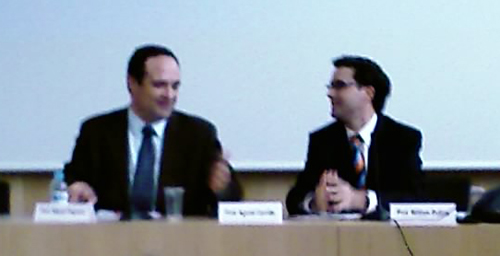Held at the IN3 headquarters in Castelldefels, Spain, on Friday March 9th, 2007, this open workshop of the MODINIS project, Breaking Barriers to eGovernment, will focus on ways in which innovation can be and has been achieved in eGovernment to improve governance in the information age. How can the widespread diffusion of the Internet and Web enable governments to transform not only the delivery of public services but also approaches to governance? The project has already identified 7 key categories of barriers to the development of eGovernment across Europe. This workshop turns attention to approaches for overcoming these barriers to stimulate innovation. These approaches span at least four key categories: legislative, technological, citizen-centric and organizational solutions.
Here come my notes for the third part of the workshop.
Identity Management (IDM) as enabler of e-Government
Mary Rundle, Berkman Center for Internet and Society, Harvard Law School, US

Mary Rundle
IDM is seen as part of the solution as governments try to: provide security (cybercrime, ISPs), guide foreign commercial relations, ensure reliable infrastructure, maintain jurisdiction (content, zoning), exercise monetary authority (flows, customs), ensure a clear system of property rights (IPR), recognize citizenship, facilitate relations between private parties (e-signature).
IDM systems: Federal Model (a third party or parties certificate your digital identity) vs. User Centric System (you hold your own digital identity). Which one is the best? How to bridge international personal data protections and the identity management infrastructure?
A proposal for an IDM system would be a CreativeCommons-like system that could be “human readable, lawyer readable, machine readable”, where all “features” (i.e. the data collected here can/will not be sold) could be tracked either by humans, at the regulation level or automatically by computers.
(Rundle gives a quick overview about NetDialogue)
Electronic Signatures
Miquel Peguera & Agustí Cerrillo, Internet Interdisciplinary Institute (IN3), Universitat Oberta de Catalunya
The researches present a study of the actual situation of the use of electronic signature in Europe, characterized by a trend to foster the use of e-signature:
- Strategies of electronic national ID cards holding digital certificates for authentication and signature purposes
- Legislative initiatives to demand specific procedures to be carried out electronically

Miquel Peguera & Agustí Cerrillo
Electronic signature regulation is a basic issue to extend its use, because it allows guaranteeing the individuals and organizations’ rights, along with the proper use of the signature itself. In this field, there have been different ways to regulate its use, depending on who led a specific e-signature initiative, the already existing legal framework and the kind of system to be implanted (free access, login/password, certificate).
All in all, there is an evident lack of coherence and integration of systems all along Europe. Particularly stress is put in the fact that the choice of a particular system is directly related to the risks and menaces that this system brings with it, causing that overlapping systems might coexist to reinforce the strength of the protection.
To overcome e-Government barriers in the field of e-signature:
- There’s a strong need of political leadership, that should act as a motor of change
- Further from being only a duty, the use of the electronic signature should also be a right (fostering demand)
- Digital national ID cards, because of their major spread, are a good target to start with for e-signature purposes
- Also in the line of demand fostering, users motivation should also be enhanced
- Multi-channel delivery of e-government services requires different kinds of electronic signature with the same level of security
To conclude:
- e-Signature as a guarantee of the relationship among citizenship and the Government/Administration
- e-Signature as a mean to allow the citizenship enjoying their rights with confidence
Workshop. Fostering Innovation in eGovernment (2007)
If you need to cite this article in a formal way (i.e. for bibliographical purposes) I dare suggest:
Peña-López, I. (2007) “Workshop. Fostering Innovation in eGovernment (part III)” In ICTlogy,
#42, March 2007. Barcelona: ICTlogy.
Retrieved month dd, yyyy from
https://ictlogy.net/review/?p=516
Previous post: Workshop. Fostering Innovation in eGovernment (part II)
Next post: Workshop. Fostering Innovation in eGovernment (part IV)
1 Comment to “Workshop. Fostering Innovation in eGovernment (part III)” »
 RSS feed for comments on this post.
TrackBack URI
RSS feed for comments on this post.
TrackBack URI


Pingback: ICTlogy » Workshop. Fostering Innovation in eGovernment (part II)